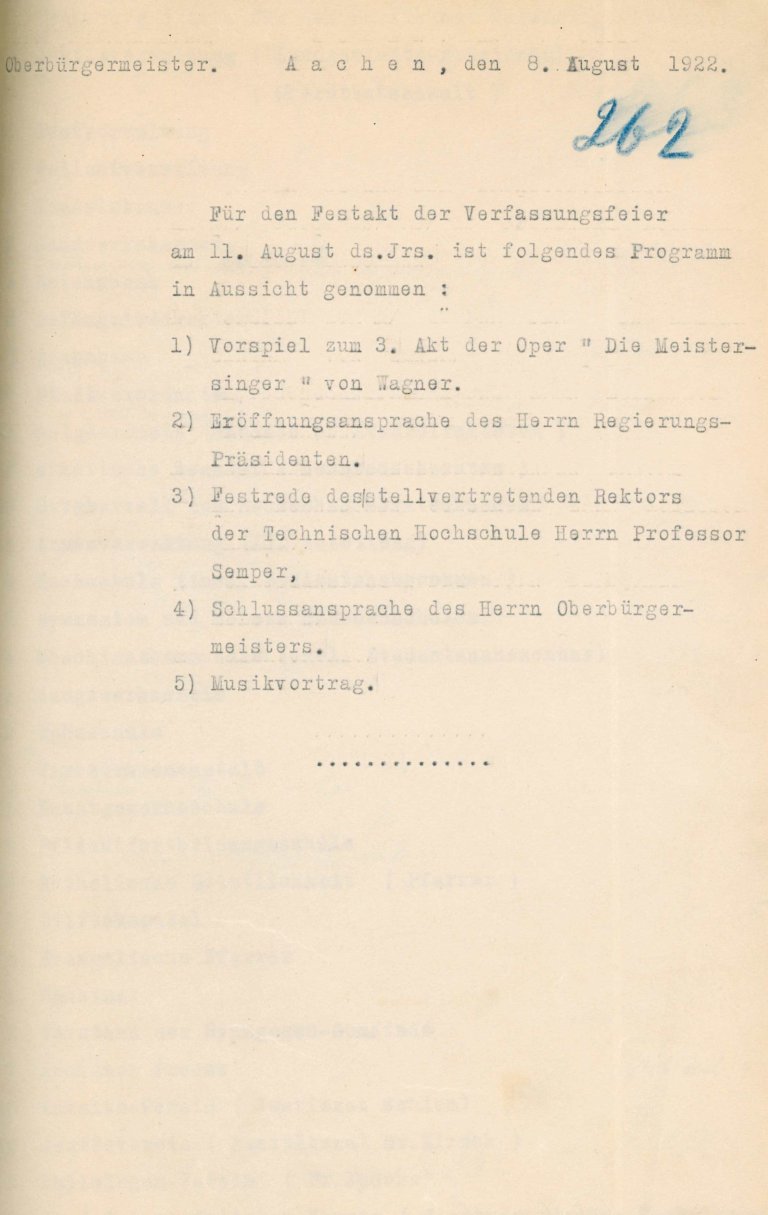Archivale of the month August 2024...
- ... shows a concept by Lord Mayor Wilhelm Farwick from August 1922 for the planned program of the first constitutional celebration in Aachen.
- After the revolution in November 1918, the freely elected German National Assembly drafted a new constitution for the German Reich, which came into force on August 11, 1919. Between 1921 and 1932, August 11 was established as a national holiday.
- On 1 August 1922, the Social Democratic Minister of the Interior Carl Severing obliged the central state authorities to prepare decentralized constitutional celebrations together with larger municipalities. In Aachen, the decision was made to hold a ceremony in the Coronation Hall of the town hall.
The Aachen City Archive regularly presents interesting items from its stacks as Archive of the Month. The item with a short accompanying text is presented in a display case in the foyer of the city archive on Reichsweg and digitally on the archive's homepage. In August 2024, the archival item of the month shows a concept by Lord Mayor Wilhelm Farwick from August 1922 for the planned program of the first constitutional celebration in Aachen.
A new constitution for the German Reich
After the revolution in November 1918, the freely elected German National Assembly drafted a new constitution for the German Reich, which came into force on August 11, 1919. It guaranteed basic fundamental rights and freedoms, introduced free and equal voting rights regardless of social status and gender and regulated the processes of parliamentary democracy. Between 1921 and 1932, August 11 was established as a national holiday.
On 1 August 1922, the Social Democratic Minister of the Interior Carl Severing obliged the central state authorities to prepare decentralized constitutional celebrations together with larger municipalities. According to his ideas, there should be "speeches and, if necessary, musical and declamatory performances", but he gave the local organizers "extensive freedom of action". However, he ordered that the population should be involved and in particular "the organizations of employers' and employees' associations, chambers of commerce and crafts, guilds, civil servants' organizations, etc." should be invited.
Short preparation time
The decree only gave the Aachen players just over a week to prepare the celebrations and coordinate them with the Belgian occupation authorities. The decision was made to hold the ceremony in the Coronation Hall of the Town Hall. Mayor Wilhelm Farwick recorded the planned program on 8 August in the concept shown here. Over 900 people were invited, representing all the important authorities, the judiciary, trade unions, churches, the Jewish community, business and professional organizations, politics and the press. The occasion of the celebration was emphasized by the display of the black, red and gold national flag in the hall and the flagging of the public buildings.
The ceremony consisted of three speeches. As the office of District President was vacant, his deputy Robert von Görschen gave the opening speech. Taking up one of Severing's suggestions, he praised the constitution as a symbol of national unity. At the same time, he complained about the burdens caused by the Treaty of Versailles and the problems of the border region. The actual keynote speech was given by the deputy rector of the Technical University, Professor Max Semper. He was not a political, legal or political scientist, but a geologist and palaeontologist. In a decidedly matter-of-fact tone, he summarized the content of the constitution and spoke about the importance of responsible governance. Mayor Farwick concluded the ceremony with a proclamation to the Republic, the Constitution and the Fatherland.
Ceremony with around one thousand guests
From 1924 onwards, this first celebration served as a model for the years to come. The focal point remained the ceremony, usually held in the town hall with around one thousand guests. For the tenth anniversary of the constitution on August 11, 1929, the President of the Government also invited the population to a celebration in the Waldstation. On the same occasion, an alliance of republican organizations around the Reichsbanner "Black-Red-Gold", SPD, trade unions and the German Peace Society called for a torchlight march. Mayor Wilhelm Rombach invited Reich President Paul von Hindenburg to the celebration in Aachen and was promised a visit on another date the following year.
The constitutional celebrations were always a reflection of the political situation. Even in ceremonial speeches, the commitment to democracy sometimes seems superficial; in individual cases, speakers also presented authoritarian and nationalist ideas at constitutional celebrations. Max Semper, the keynote speaker in 1922, also turned to so-called "racial studies" during the Weimar Republic. And after a few years, fatal weaknesses in the constitution became apparent, as it enabled the Reich President to rule in an authoritarian manner with emergency decrees. From 1930, Hindenburg undermined parliamentary democracy in this way, before initiating the transition to the Nazi dictatorship with Hitler's appointment as Reich Chancellor in 1933.
You can subscribe to our RSS feed for our press releases here https://www.aachen.de/rss-feed-pressemitteilungen/rss.xml
